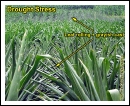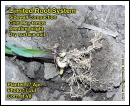

![]() ack in mid-June, I discussed the fact that some of
Indiana’s corn crop was suffering from more than its fair share of
Too Much Danged Stress (Some Corn Afflicted
With TMDS Syndrome). In late June, I tried to reinforce the notion that a
number of stresses are to blame this year and that every situation likely
results from a different set or combination of stresses (Too Much Dang Stress – Recap). Last week, I
discussed the importance of the timing of stress relative to crop growth stage
plus the existence of other complicating stresses in determining whether or not
subsequent crop stunting occurs (Timing of
Crop Stress is Critical!).
ack in mid-June, I discussed the fact that some of
Indiana’s corn crop was suffering from more than its fair share of
Too Much Danged Stress (Some Corn Afflicted
With TMDS Syndrome). In late June, I tried to reinforce the notion that a
number of stresses are to blame this year and that every situation likely
results from a different set or combination of stresses (Too Much Dang Stress – Recap). Last week, I
discussed the importance of the timing of stress relative to crop growth stage
plus the existence of other complicating stresses in determining whether or not
subsequent crop stunting occurs (Timing of
Crop Stress is Critical!).
I think it is reasonable to note at this point in time that a fair number of Indiana’s corn fields continue to suffer from the effects of early stresses that are now compounded by the enduring dry spell that grips some areas in the state. The technical term for the problem is acronymized as WTMDS, otherwise known as Way Too Much Danged Stress!
 As more and more of the
state’s corn crop enters the critical pollination period, the potential
yield effect of severe drought stress increases to maximums of about 4% per day
during the two weeks prior to silking, 8% per day during silking, and 6% per
day during the two weeks following silking. Recognize that these estimated
yield losses are in response to SEVERE drought stress as
characterized by leaf rolling from sunup to sundown plus a grayish cast to the
leaves. Lesser yield loss would be expected, if any, from lesser degrees of
soil moisture deficits.
As more and more of the
state’s corn crop enters the critical pollination period, the potential
yield effect of severe drought stress increases to maximums of about 4% per day
during the two weeks prior to silking, 8% per day during silking, and 6% per
day during the two weeks following silking. Recognize that these estimated
yield losses are in response to SEVERE drought stress as
characterized by leaf rolling from sunup to sundown plus a grayish cast to the
leaves. Lesser yield loss would be expected, if any, from lesser degrees of
soil moisture deficits.
The potential yield loss results from a combination of possible factors, take your pick: 1) delayed silk emergence plus shorter pollen shed duration resulting in asynchrony (poor timing) of pollen shed and silk availability, 2) silks not receptive to pollen grain germination as a result of silk desiccation, and 3) abortion of fertilized ovules during the first week or two after pollination. Pollen viability itself is commonly not an issue during drought stress unless temperatures surpass 100oF for a number of consecutive days.
The drought stress that prevails in some areas of the state would likely not be severe by itself. The various and sundry early season stresses in some fields are greatly compounding the effects of drought stress on the corn crop. The range of outward symptoms of the current drought stress can be categorized by increasing levels of severity from A) minor leaf rolling during the heat of the day, B) leaf rolling many hours of the day, C) leaf rolling from sunup to sundown plus a grayish cast to the leaves, D) leaf death (bleached straw color leaves), or E) dead corn plants. Obviously, the latter symptom directly affects yield potential as it affects harvestable plant population.
A recap of the variety of stresses that occurred earlier in the season or, in some cases, continue to linger in their drought-enhanced effects on the corn crop include:
Example of restricted root system: |
 |
 For other
information about corn, take a look at the Corn Growers Guidebook on the World
Wide Web at http://www.kingcorn.org
For other
information about corn, take a look at the Corn Growers Guidebook on the World
Wide Web at http://www.kingcorn.org